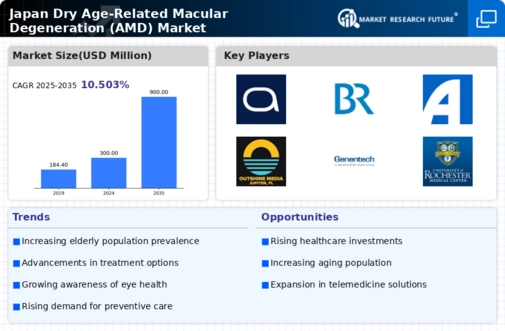Aging Population
The Global Japan Dry Age-Related Macular Degeneration (AMD) Market Industry is significantly influenced by the aging demographic in Japan. As the population ages, the prevalence of age-related diseases, including dry AMD, is expected to rise. By 2024, the market is projected to reach 3250 USD Million, reflecting the urgent need for effective treatments and management strategies. The increasing number of elderly individuals, who are more susceptible to AMD, underscores the necessity for healthcare systems to adapt and provide adequate resources. This demographic shift not only drives demand for AMD-related healthcare services but also stimulates innovation in therapeutic options.
Market Growth Projections
The Global Japan Dry Age-Related Macular Degeneration (AMD) Market Industry is expected to experience notable growth in the coming years. Projections indicate that the market will reach 3250 USD Million by 2024 and could expand to 5500 USD Million by 2035. This anticipated growth reflects a compound annual growth rate of 4.9% from 2025 to 2035, driven by various factors including an aging population, advancements in treatment options, and increased awareness. The upward trajectory of the market underscores the importance of continued investment in research, technology, and healthcare infrastructure to meet the needs of patients suffering from dry AMD.
Advancements in Treatment Options
Innovations in treatment modalities are propelling the Global Japan Dry Age-Related Macular Degeneration (AMD) Market Industry forward. Recent developments in pharmacological therapies, including the introduction of new drugs and combination therapies, have shown promise in slowing disease progression. These advancements are crucial as they address the unmet needs of patients suffering from dry AMD. The market is expected to grow, with projections indicating a rise to 5500 USD Million by 2035. This growth is indicative of the ongoing research and development efforts aimed at enhancing patient outcomes and quality of life, thereby attracting investment and interest from pharmaceutical companies.
Increased Awareness and Screening
Raising awareness about dry AMD and the importance of early detection is a key driver for the Global Japan Dry Age-Related Macular Degeneration (AMD) Market Industry. Public health campaigns and educational initiatives are encouraging individuals, particularly those over 50, to undergo regular eye examinations. This proactive approach is likely to lead to earlier diagnosis and treatment, ultimately improving patient outcomes. As awareness increases, the demand for screening services and related healthcare products is expected to rise, contributing to market growth. The focus on preventive care aligns with broader health trends, emphasizing the need for comprehensive eye health strategies.
Technological Integration in Healthcare
The integration of technology into healthcare practices is transforming the Global Japan Dry Age-Related Macular Degeneration (AMD) Market Industry. Telemedicine, artificial intelligence, and advanced imaging techniques are enhancing the diagnosis and management of dry AMD. These technologies facilitate remote consultations and improve the accuracy of disease detection, making healthcare more accessible. As the market evolves, the adoption of these innovations is likely to attract a broader patient base, thereby increasing market size. The potential for technology to streamline patient care processes and improve treatment adherence suggests a promising future for the industry.
Growing Investment in Research and Development
Investment in research and development is a critical factor driving the Global Japan Dry Age-Related Macular Degeneration (AMD) Market Industry. Pharmaceutical companies and research institutions are increasingly allocating resources to explore new therapeutic avenues and improve existing treatments. This focus on R&D is essential for addressing the complexities of dry AMD and developing effective interventions. With a projected compound annual growth rate of 4.9% from 2025 to 2035, the market is poised for substantial growth. The commitment to innovation not only enhances treatment options but also fosters collaboration among stakeholders, including academia and industry.
























Leave a Comment